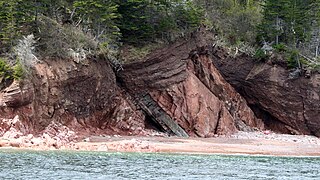
Archaeothyris is an extinct genus of ophiacodontid synapsid that lived during the Late Carboniferous and is known from Nova Scotia. Dated to 306 million years ago, Archaeothyris, along with a more poorly known synapsid called Echinerpeton, are the oldest undisputed synapsids known. The name means ancient window (Greek), and refers to the opening in the skull, the temporal fenestra, which indicates this is an early synapsid. Protoclepsydrops also from Nova Scotia is slightly older but is known by very fragmentary materials.
Protoclepsydrops is an extinct genus of early synapsids, found in Joggins, Nova Scotia. The name means 'first Clepsydrops', and refers to it being the predecessor of the other early synapsid Clepsydrops.

Paleothyris was a small, agile, anapsid romeriidan reptile which lived in the Middle Pennsylvanian epoch in Nova Scotia. Paleothyris had sharp teeth and large eyes, meaning that it was likely a nocturnal hunter. It was about a foot long. It probably fed on insects and other smaller animals found on the floor of its forest home. Paleothyris was an early sauropsid, yet it still had some features that were more primitive, more labyrinthodont-like than reptile-like, especially its skull, which lacked fenestrae, holes found in the skulls of most modern reptiles and mammals.

Microsauria is an extinct, possibly polyphyletic order of tetrapods from the late Carboniferous and early Permian periods. It is the most diverse and species-rich group of lepospondyls. Recently, Microsauria has been considered paraphyletic, as several other non-microsaur lepospondyl groups such as Lysorophia seem to be nested in it. Microsauria is now commonly used as a collective term for the grade of lepospondyls that were originally classified as members of Microsauria.

Dendrerpeton is a genus of an extinct group of temnospondyl amphibians. Its fossils have been found primarily in the Joggins Formation of Eastern Canada and in Ireland. It lived during the Carboniferous and is said to be around 309–316 million years of age, corresponding to more specifically the Westphalian (stage) age. Of terrestrial temnospondyl amphibians evolution, it represents the first stage. Although multiple species have been proposed, the species unanimously recognized is D. acadianum. This species name comes from “Acadia” which is a historical name for the Nova Scotia region as a French colony. It refers to the location of the coal field at which the fossil was found.
Walter Andrew Bell was a Canadian geologist. He worked for the Geological Survey of Canada for over 40 years and authored or co-authored 70 publications. Most of them concerning Carboniferous stratigraphy, paleobotany and paleontology of Atlantic Canada. He also contributed significantly to central and western Canadian Mesozoic and Cenozoic paleobotany. His work provided support for the theory of continental drift.

Cochleosaurus (“spoon lizard”, from the Latin cochlear "spoon" and Greek sauros “lizard”_ were medium-sized edopoid temnospondyls that lived in Euramerica during the Muscovian period. Two species, C. bohemicus and C. florensis, have been identified from the fossil record.

Diplichnites are arthropod trackways with two parallel rows of blunt to elongate, closely spaced tracks oriented approximately perpendicularly to the mid-line of the trackway. The term is more often used for the ichnofossils of this description; however, similar trackways from recent arthropods are sometimes given this name as well.
Letognathus is a genus of rhizodont tetrapodomorph that lived during the Carboniferous period. Its remains come from the Blue Beach Member of the Horton Bluff Formation, near Hantsport, Nova Scotia. Like most rhizodonts, it was of relatively large size, had a large recurved fang at the symphysis of the lower jaw, and a row of three coronoid fangs along the length of the jaw in addition to its marginal dentition. Letognathus is important for rhizodont systematics because it retains a number of primitive features, such as ossified Meckel's cartilage, are not found in the genera Rhizodus and Strepsodus.

Leiocephalikon is an extinct genus of microsaur within the family Gymnarthridae. The type species is Amblyodon problematicum named by John William Dawson in 1882. Its fossil was found in the Joggins Formation which hailed from Carboniferous period. Although sometimes regarded as primitive gymnarthrids, Leiocephalikon classification is still debated as its fossil is scarce.

Bendenius is an extinct genus of prehistoric marine ray-finned fish. It is known from the Early Carboniferous of Belgium. It was named after Belgian paleontologist Pierre-Joseph van Beneden.

Tuditanidae is an extinct family of microsaurian tetrapods. Fossils have been found from Nova Scotia, Ohio, and the Czech Republic and are Late Carboniferous in age.
Calligenethlon is an extinct genus of embolomere tetrapodomorphs from the Late Carboniferous of Joggins, Nova Scotia. It is the only definitively identified embolomere from the Joggins Fossil Cliffs and is the largest tetrapod to have been found preserved in lycopod tree stumps.
The Cumberland Formation is a geologic formation in Nova Scotia. It preserves fossils dating back to the Carboniferous period.

The Horton Bluff Formation is a geologic formation in Nova Scotia. It preserves fossils dating back to the Carboniferous period. It is located 2.5 kilometres southeast of Avonport Station.
The Parrsboro Formation is a geologic formation in Nova Scotia. It preserves fossils dating back to the Carboniferous period.

The Stellarton Formation is a geologic formation in Nova Scotia. It preserves fossils dating back to the Carboniferous period.
The Cumberland Group is a geologic group in Nova Scotia. It preserves fossils dating back to the Carboniferous period.

The Mabou Group is a geologic group in Nova Scotia. It preserves fossils dating back to the Carboniferous period.
The Riversdale Group is a geologic group in Nova Scotia. It preserves fossils dating back to the Carboniferous period.


















